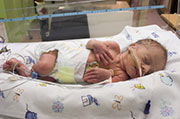- Skip Storing This Everyday Product in the Fridge Door
- Green Tea + B3 Pairing May Boost Brain Health
- Navigating Your Midlife Crisis: Embracing New Possibilities
- City Raccoons Showing Signs of Domestication
- Mapping the Exposome: Science Broadens Focus to Environmental Disease Triggers
- One Week Less on Social Media Linked to Better Mental Health
- Your Brain Changes in Stages as You Age, Study Finds
- Some Suicide Victims Show No Typical Warning Signs, Study Finds
- ByHeart Formula Faces Lawsuits After Babies Sickened With Botulism
- Switch to Vegan Diet Could Cut Your Greenhouse Gas Emissions in Half
Preterm Boys Face Worse Odds Than Girls, Study Says


Boys are 14 percent more likely than girls to be born prematurely, and preterm boys have a greater risk of disability and death than preterm girls, new research finds.
These disabilities range from learning problems, blindness or deafness, to motor problems such as cerebral palsy, according to the authors of six studies published in the journal Pediatric Research in advance of World Prematurity Day on Nov. 17.
“Baby boys have a higher likelihood of infections, jaundice, birth complications and congenital conditions, but the biggest risk for baby boys is due to preterm birth,” research team leader Dr. Joy Lawn, a professor and neonatologist and epidemiologist at the London School of Hygiene & Tropical Medicine in England, said in a journal news release.
“For two babies born at the same degree of prematurity, a boy will have a higher risk of death and disability compared to a girl,” Lawn said. “Even in the womb, girls mature more rapidly than boys, which provides an advantage, because the lungs and other organs are more developed,” she explained.
“One partial explanation for more preterm births among boys is that women pregnant with a boy are more likely to have placental problems, pre-eclampsia [a serious complication], and high blood pressure,” conditions which are all associated with preterm births, Lawn added.
However, the study authors pointed out, preterm girls are more likely than boys to die in the first month of life in some countries where girls receive less nutrition and medical care than boys.
The risk of disability and death varies depending on where a preterm baby (less than 37 weeks’ gestation) is born, the investigators found. More than 80 percent of preterm infants in high-income countries survive and thrive. The risk of death and disability is greatest for those born at less than 28 weeks.
In middle-income countries, the risk of disability for infants born at 28 to 32 weeks is double that of those in high-income countries. In low-income countries, preterm babies are 10 times more likely to die than those in high-income countries. Death is twice as likely as disability for preterm babies in these countries.
For the study, the researchers analyzed data from more than 15 million preterm babies worldwide. Of the 13 million who survived beyond the first month of life, 4.4 percent had mild disability and 2.7 percent had moderate or severe disability.
The largest number of problems among preterm infants occurred in low-income countries in South Asia and sub-Saharan Africa, where 2.2 million died and more than 600,000 had some degree of disability, according to the study findings.
India had the greatest number of preterm births at over 3.2 million. China had less than half that number — 1.3 million — followed by Nigeria, Pakistan and Indonesia. The United States recorded nearly 498,000 preterm births.
Malawi had the highest rate of preterm birth at 18.1 per 1,000 live births, the report noted.
More information
The American Academy of Pediatrics outlines health issues faced by premature babies.
Source: HealthDay
Copyright © 2025 HealthDay. All rights reserved.










